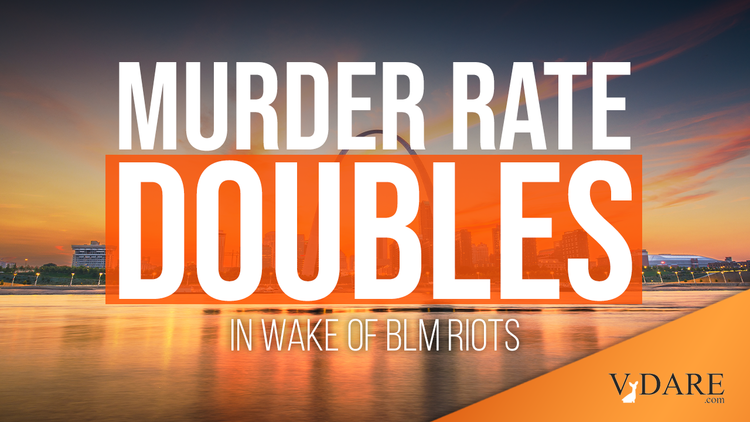


By Steve Sailer
09/21/2020
Earlier:Homicides In St. Louis: From the Ferguson Effect to the Floyd Effect and Well, There’s Your Problem Right There, Baltimore: "The Freddie Gray Effect"
From the St. Louis Post-Dispatch:
Amid ‘indescribable times,’ St. Louis homicide rate reaches historic levels
Kim Bell 7 hrs ago 150ST. LOUIS — The same scenes play out time and again for police Lt. Scott Aubuchon’s homicide detectives when they arrive to investigate another death in the city: yellow police tape, the wails of family and evidence technicians scouring for bullet casings.
Aubuchon’s team is struggling to keep up as the city contends with a homicide rate that, by year’s end, likely will be the worst in at least a half-century.
The number of killings soared over the summer as detectives were called to 114 homicides in June, July and August. There were 53 people killed in the city in July alone.
“Since June 1, our numbers began to rise at the alarming rate,” said Aubuchon, the homicide unit’s commander since 2018. “We’ve never seen anything like the last three months. These are indescribable times.”
What happened on Memorial Day this year that might have set off the murder spree by June 1? Oh, yeah, George Floyd died.
The same can be said for the year.
The shooting death last Monday of a 15-year-old girl in the Riverview neighborhood was the 194th homicide of the year, matching the city’s total for all of 2019. That number has since been surpassed. If the pace of killings continues, St. Louis will reach an ignoble milestone. Over the past decade, the city has averaged 50 homicides in the last four months of the year, according to police statistics. If that holds true, St. Louis will see about 240 homicides in 2020, the highest in 25 years.
The murder rate in St. Louis in 2013, before the beginning of Black Lives Matter, was 37.7. Then in 2014, with Ferguson and BLM happening in August, it jumped to 49.9. Since 2015, the murder rate in St. Louis has never been below 59. This year it appears to be headed for 79, more than double the murder rate in 2013, the last year before the Ferguson/BLM effect.
Year Pittsburgh St. Louis Memphis Cincinnati Baltimore
2019-01-01 12.3 64.5 29.3 24 58.6
2018-01-01 18.8 61.4 2 8.5 18.9 51
2017-01-01 18 66.4 27.7 23.4 55.8
2016-01-01 18.8 59.8 29.8 19.1 51.4
2015-01-01 18.6 59.3 20.5 22.1 55.4
2014-01-01 22.4 49.9 21.4 20.1 33.8
2013-01-01 14.6 37.7 18.8 23.6 37.4
2012-01-01 13.1 35.5 20.2 15.5 34.8
2011-01-01 14.2 35.3 17.9 20.5 31.2
2010-01-01 17.6 40.5 13.2 20.4 34.8
Baltimore had a similar Ferguson Effect jump from 2014 to 2015 (with the Freddie Gray riot on April 25, 2015). The Ferguson/BLM Effect is one of the most obvious in the history of the social sciences, which is why you almost never hear about it.
The highest number of killings in a single year in St. Louis was 267 in 1993, when the city had some 387,000 residents. That means the homicide rate — homicides per 100,000 people — was 69 that year. But the population of St. Louis has continued to dwindle over the decades, settling now at just over 300,000. The result this year is a homicide rate that’s projected to be 79, a startling number that appears to exceed the rate for any other large U.S. city. …
Most of the deaths in St. Louis are not solved, making it difficult for detectives to pinpoint motives, but Aubuchon said the motive in the killings that have been solved are “all over the place.”
“Random fights that escalate,” Aubuchon said. “Some folks under the influence of drugs. Arguments over stolen money.”
One key difference detectives have noticed is the relationship between killer and victim. They seem to be closer: family members and close friends. In the past it was more likely to be an acquaintance or, rarely, a stranger, Aubuchon said. …
Finding witnesses willing to cooperate with investigators has always been a challenge for St. Louis police, and Aubuchon said the pandemic is making it even harder.
… A majority of the victims this year (156) have been Black men and boys. As of last week, police said they have suspects in just 69 cases, and most were Black males.
But now that we have started capitalizing Black males, they will no doubt, real soon now, stop shooting other Black males so often.
More than half of the killings are in the northern part of St. Louis and nearly all of the killings are carried out with a firearm.
The motive is elusive. For the cases in which a reason is listed, 18 involved an argument, six involved a burglary and fewer than 10 victims were thought to be killed for drugs or in retaliation.
Police have identified suspects in 47 killings this year, but about three-fourths of the murders remain unsolved. …
And this July, Chief Hayden said in the midst of the particularly violent summer that people seemed to have “shorter fuses.”
It’s almost as if the media lecturing black people daily on how they ought to angry isn’t good for black people.